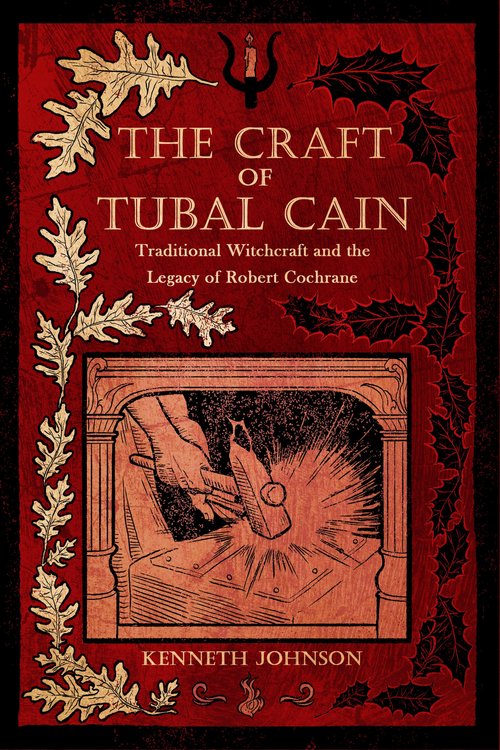
I remember when I first read about Christian Witches a long time ago. The idea seemed ridiculous to me at the time, because how can you be on good terms with the Christian god and the Devil at the same time? It seemed greedy.
But there are figures from the Bible that have struck me with fascination. Except for Eve, almost all of them are the bad guys: the serpent, Judas Iscariot, Cain. And, of course, Satan.
However, not even once had I read about Tubal Cain, much less heard about him becoming a figure in a tradition of Witchcraft. It turns out you never know everything. (Imagine that!) I wanted to learn more about this guy and how he is connected to the history of Witchcraft.
Enter The Craft of Tubal Cain: Traditional Witchcraft & the Legacy of Robert Cochrane, by Kenneth Johnson.

Cover to Kenneth Johnson’s “The Craft of Tubal Cain: Traditional Witchcraft adn the Legacy of Robert Cochrane.” [Crossed Crow Books]
- Publisher: Crossed Crow Books
- Paperback Publication Date: 12/10/2024
- Hardcover Publication Date: 11/01/2024
- Print Length: 240 pages
- Tags: history, introductory, nonfiction, traditional witchcraft, psychic development, spirituality, Witchcraft
During the chaotic but colorful 1960s, Witchcraft was reborn as a modern mystical practice. Many are familiar with Wicca, founded by Gerald Gardner, but there was a counter-current, now known as Traditional Witchcraft, which saw the art from a very different angle. Its chief thinker was Robert Cochrane, who envisioned Witchcraft as a gnostic quest for ultimate knowledge and union with the divine. This volume explores his most important ideas, especially the way in which he re-envisioned ancient mythology, putting a new spin on old deities as well as on folkloric figures like Robin Hood and King Arthur, and naming Tubal Cain, whom the Bible calls the first blacksmith, as his avatar of knowledge both sacred and profane. Though he wrote very little and died young, Cochrane left enough material behind him for us to reconstruct the steps by which he urged each aspiring Witch to take a crooked path to complete gnosis.
The first chapters were fascinating. There’s this comparison with Wicca, born around the same time that Cochrane worked on his spiritual beliefs and shared them with others. Far from attacking Wicca, the book shows the differences between both beliefs and how they can be seen as two sides of the same coin.
There were times I agreed and others when I didn’t so much with what Cochrane was proposing at the time, but I could understand the ideas and where they came from. Kenneth Johnson has a very descriptive and detailed style that helps you see how things come to be one way or the other.
There is also a particular element to the book that I liked, which is the author’s personal correspondence with Shani Oates, the Matriarch of the Clan of Tubal Cain. Her insight gave the author a lot of material to work on because, as he mentions, there’s little written material by Cochrane himself. This gives the whole project an aura of mystery, something forbidden that we shouldn’t know, which adds to the book’s charm.
I must admit, however, that I had some issues with this book’s later chapters because they seemed to deviate from the subject at hand. The topics they explored seemed to be complementary, but not directly related to Cochrane. Unquestionably, they expand on knowledge and the mythos, but they don’t add much to what is being explored other than expanding the background.
When I learn anything about Witchcraft, I want to know where the ideas come from, and how those ideas translate into something practical. There is a lot of history and folklore involved, and don’t get me wrong, it is interesting, but I wanted to see how those ideas affected or shaped the clan, how to incorporate them in my craft, what they mean in the modern world. To some degree, I felt this was presented as knowledge for the sake of knowledge.
All in all, this is a fascinating book that helps a reader examine the other side of the coin that we often get presented with when we get started in Witchcraft. I remember those days I spent devouring everything I could get my hands/eyes on that had to do with it, and how it shaped some aspects of myself until there was something missing.
For me, this is a book that presents that missing aspect of Witchcraft, wilder and raw, untamed, yet still gentle to some degree. It is not perfect, no book can ever aspire to be, even less when it comes to Witchcraft, but it does a great job of offering an alternative point of view.
It has a nice writing style, a good pace, and an intriguing ideas that would be beneficial to every Witch regardless of their practice. There’s a mix of history and folklore that always comes in hand, along with a different moral compass that, some might argue, is closer to what’s found in the wilderness, in nature. It’s up to the reader to decide what’s what.
Thanks to Crossed Crow Books for providing a review copy.
The Wild Hunt is not responsible for links to external content.
To join a conversation on this post:
Visit our The Wild Hunt subreddit! Point your favorite browser to https://www.reddit.com/r/The_Wild_Hunt_News/, then click “JOIN”. Make sure to click the bell, too, to be notified of new articles posted to our subreddit.
